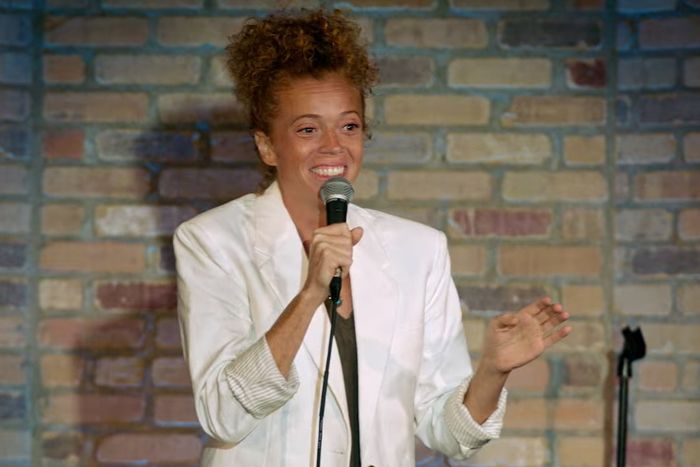
Aside from a few notable outliers, 2023 has been an unremarkable year for comedy specials. “Unremarkable” is not the same as “bad” — many of the specials out this year — especially from bigger and more established names like Wanda Sykes, Nate Bargatze, Hannah Gadsby, and Kevin Hart — are perfectly pleasant, well-produced, often enjoyable hours of comedy. But they’re not all that special, at least not in the way really exciting comedy specials can be when they’re done well: when there’s a coherent idea for an hour, the visuals are thoughtful and striking, and there’s a clear and unmistakable purpose for the show that goes beyond, “Happily, I have signed a contract to film a special.”
Again: This is not bad! Not everything’s going to be Rothaniel, you know? It can’t (and shouldn’t!) always be Mo’Nique pulling the ripcord on a career retrospective, or John Early doing a high-concept concert-film parody. But formally and aesthetically, the comedy special as an object hasn’t offered much wiggle room or flexibility to accompany the differences in types of show. An hour-long set of a comedian simply standing onstage can certainly be a monumental, impeccably built, very special kind of special. That could be an Anthony Jeselnik approach to very punchline-centric jokes, or a Mike Birbiglia long-form narrative style, or — she’s going to say it — Nanette. But many hour-long comedy specials are less cohesive and deliberately meticulous. They’re in the “perfectly pleasant” category, even though they often look and are shaped in the same model of the “This is a big important deal” special. Unless a comedian comes in with a palpably off-the-wall concept that’s reflected in the special’s design, like Moses Storm’s 2022 special Trash White, the baseline of “hour-long footage of a person onstage, with occasional reaction shots of audience laughing” can make everything blur together. Where is the middle ground between “This is a big deal” and “Here are some good jokes that don’t really fit together, which I could also just harvest for my YouTube page”?
This, more than anything else, is what’s most exciting about Michelle Wolf’s new Netflix special (series?), It’s Great to Be Here. The material itself is a mixed bag at best. Wolf is a better and more careful writer than many, but the conceptual groundwork is frustratingly hung up on Chappelle and Louis C.K.–adjacent ideas: gender norms, transphobia, cancel-culture panic. There are other sections, too — a part about Wolf’s life with her boyfriend in Barcelona, an argument about the emptiness of inclusive beauty campaigns, a joke about Nancy Reagan. It’s an update on Wolf’s life, with material about what she’s thinking about, what she’s doing, and how she feels about certain topical issues. It does not hang together as one big, cohesive approach to an hour of comedy, and not just because it’s well over an hour long.
But unlike any number of the specials out this year that also come from a Life Update sort of place, Wolf’s is structured to embrace the casual. Rather than a single hour, it’s split across three smaller parts that run in the 20- to 35-minute range. Those parts are also split up into their own smaller sections, with little interstitial title cards to designate separate areas. There’s one called “New Neighborhood” and another one called “Me Too” (sigh). The parts aren’t structured like TV episodes, but they do signal some of the same fundamental ideas. Sections can stand alone. They’re not quite interchangeable, but they resemble one another. And most importantly, they can be watched as a comfortable screen companion, not as enormous events. They’re small, on purpose.
The visual and production design supports a tone of relaxed ordinariness. There’s footage from shows taped at a few small venues across the United States, with each section presented from whichever city’s taping happened to have the best show. The mics all sound a little crunchy. There are a few different camera angles but none of the audience-reaction shots that tend to cover up edits that stitch together multiple shows. It looks and sounds like a better-quality version of what happens when a comedian clips a camera to the doorframe of a comedy club to record a set just in case they want to post it later. The overall impression is more effectively authentic than when comedians try to overtly signal authenticity, because it’s a more appropriate meeting of form and content. It’s not Amy Schumer standing on a stage in front of a huge chandelier while presenting rote material about what’s going on with her lately, but it’s also a little more polished and thoughtful than the garden-variety YouTube-special look.
Is this kind of special profitable? How much does it cost versus a standard hour-long stage setup? How much did Netflix pay for it? Does the multiple-parts element better feed into Netflix’s algorithm? Do Netflix viewers prefer shorter chunks? None of that is clear, but it’s easy to speculate that the answers to those last two questions might be “yes.” Economics aside, it would be good to see more comedians adopt this approach to a special. The debuts, experiments, and thrilling, electric hour-long performances deserve attention and appreciation; the smaller everyday performances by great working comedians can be just as appealing. There’s no need to smash all of those things into the same general shape. Let specials be special. Make more space for well-made comedy shows.


